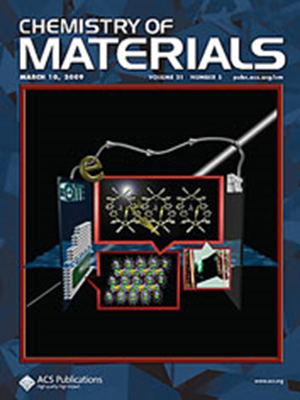微反应器室温流动合成Pd-Ru固溶合金纳米颗粒及其一氧化碳氧化催化性能
IF 7.2
2区 材料科学
Q2 CHEMISTRY, PHYSICAL
引用次数: 0
摘要
固溶体合金的电子态可以通过调整其组成来调节,从而影响其物理和化学性质。通过纳米化,即使对于不相容的元素,也可以形成固溶体,但传统的合成这种合金纳米颗粒(ANPs)通常需要苛刻的条件,如高温、高压和有机溶剂。因此,开发更简单的低温液相合成方法是非常必要的。然而,在前驱体溶液混合不足时,反应物扩散阻碍了均匀成核和组成控制。在本研究中,我们利用具有优异混合性能的微反应器,在室温下在水溶液中合成了Pd-Ru ANPs,形成了均匀的反应场。该技术允许在成核前同时还原不同的离子,从而实现精确的成分控制。所得的Pd-Ru ANPs具有均匀的尺寸和组成,与单金属纳米颗粒相比,其催化性能表现出更强的活性,通过一氧化碳(CO)氧化率测量进行了评估。值得注意的是,在室温条件下,Ru含量的增加导致结晶度降低和局部结构紊乱。这种独特的结构特征使其在较低Pd组成下具有最佳的CO氧化活性。该方法为在温和条件下合成可控成分的ANPs提供了一种简单有效的方法。本文章由计算机程序翻译,如有差异,请以英文原文为准。

Room-Temperature Flow Synthesis of Pd–Ru Solid-Solution Alloy Nanoparticles Using Microreactor and Catalytic Performance of Carbon Monoxide Oxidation
The electronic states of solid-solution alloys can be regulated by tuning their composition, thereby affecting their physical and chemical properties. Through nanosizing, solid solution formation can be achieved even for immiscible elements, but conventional synthesis of such alloy nanoparticles (ANPs) often requires harsh conditions, such as high temperature, pressure, and organic solvents. Therefore, developing simpler, low-temperature, liquid-phase synthesis methods is highly desirable. However, reactant diffusion during insufficient mixing of precursor solutions hinders uniform nucleation and composition control. In this study, we synthesized Pd–Ru ANPs in an aqueous solution at room temperature using a microreactor with excellent mixing performance, which created a uniform reaction field. This technique allowed the simultaneous reduction of different ions before nucleation, enabling precise composition control. The resulting Pd–Ru ANPs exhibited uniform size and composition, and their catalytic properties showed enhanced activity compared to monometallic nanoparticles, as evaluated via carbon monoxide (CO) oxidation rate measurements. Notably, under room-temperature conditions, increasing Ru content resulted in a reduced crystallinity and induced localized structural disorder. This unique structural feature enabled optimal CO oxidation activity at a lower Pd composition than that reported previously. This method provides a simple and effective approach for the synthesis of ANPs with controlled compositions under mild conditions.
求助全文
通过发布文献求助,成功后即可免费获取论文全文。
去求助
来源期刊

Chemistry of Materials
工程技术-材料科学:综合
CiteScore
14.10
自引率
5.80%
发文量
929
审稿时长
1.5 months
期刊介绍:
The journal Chemistry of Materials focuses on publishing original research at the intersection of materials science and chemistry. The studies published in the journal involve chemistry as a prominent component and explore topics such as the design, synthesis, characterization, processing, understanding, and application of functional or potentially functional materials. The journal covers various areas of interest, including inorganic and organic solid-state chemistry, nanomaterials, biomaterials, thin films and polymers, and composite/hybrid materials. The journal particularly seeks papers that highlight the creation or development of innovative materials with novel optical, electrical, magnetic, catalytic, or mechanical properties. It is essential that manuscripts on these topics have a primary focus on the chemistry of materials and represent a significant advancement compared to prior research. Before external reviews are sought, submitted manuscripts undergo a review process by a minimum of two editors to ensure their appropriateness for the journal and the presence of sufficient evidence of a significant advance that will be of broad interest to the materials chemistry community.
 求助内容:
求助内容: 应助结果提醒方式:
应助结果提醒方式:


